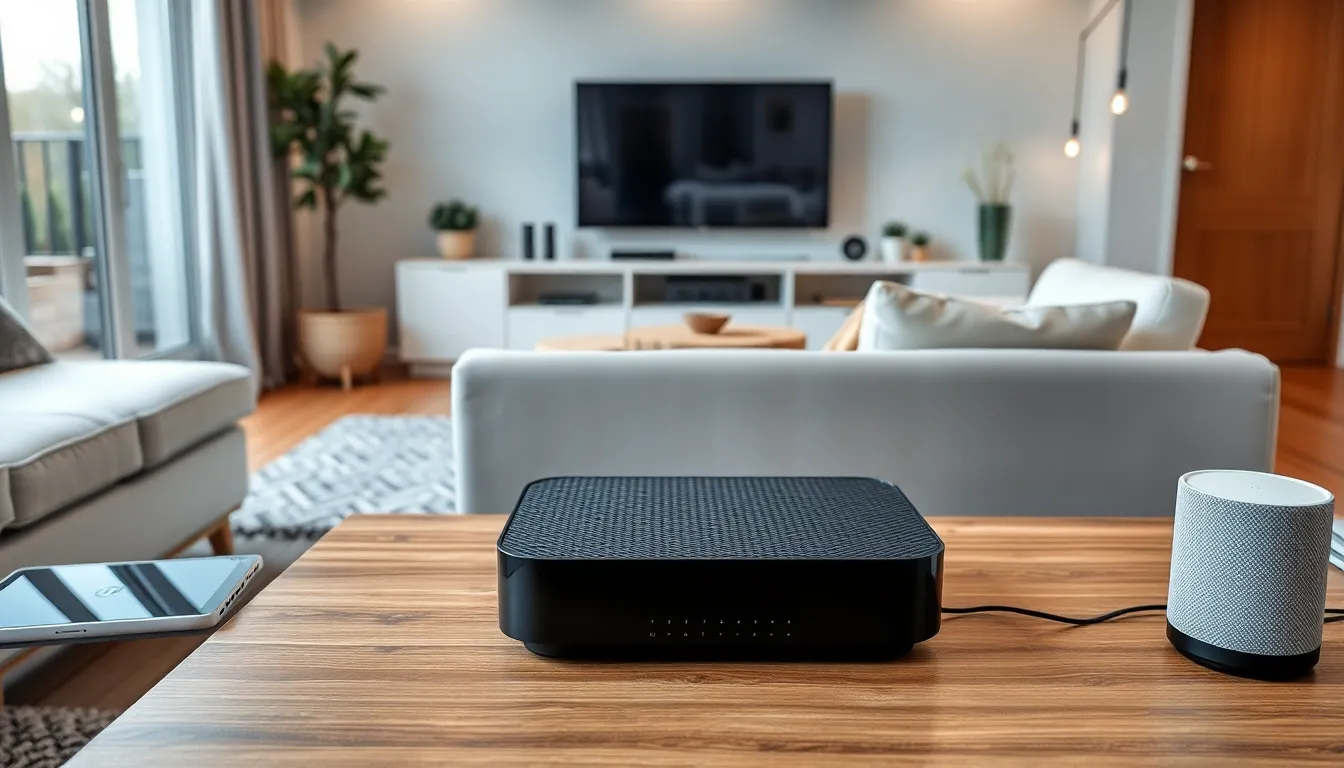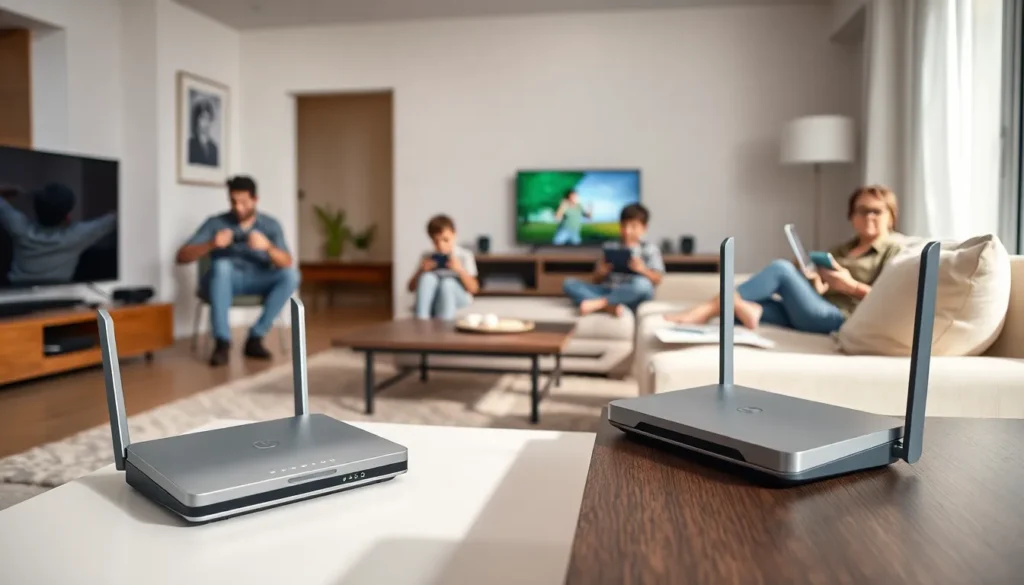In today’s tech-savvy world, a reliable home network isn’t just a luxury; it’s a necessity. Whether it’s streaming your favorite shows in 4K or battling it out in the latest online game, a strong network connection can make or break the experience. Advanced home networking solutions can transform your humble abode into a digital fortress, ensuring you never have to endure the dreaded buffering wheel again.
Table of Contents
ToggleOverview of Advanced Home Networking Solutions
Advanced home networking solutions address the growing demands of modern households. They enhance connectivity for multiple devices, ensuring seamless access to the internet. Mesh Wi-Fi systems represent a popular choice, distributing signals uniformly throughout various spaces. These systems eliminate dead zones and enhance speeds.
Powerline adapters offer another solution by utilizing existing electrical wiring. When plugged in, these adapters extend the network without installing additional cables. Wi-Fi extenders also improve range, capturing weak signals and amplifying them to reach further areas.
Smart home integration has become essential. Devices such as smart speakers, thermostats, and security cameras require stable connections. Networking solutions with quality of service (QoS) features prioritize bandwidth for crucial applications, ensuring lag-free performance during high-demand activities.
Another consideration involves security. Modern home networks increasingly include security protocols to protect sensitive data. Using WPA3 encryption adds an additional level of protection against unauthorized access.
Finally, centralized management platforms simplify network control. Users benefit from intuitive interfaces, real-time monitoring, and analytics tools. These aspects facilitate effective management of the entire home network, identifying issues proactively and ensuring optimal performance.
Advanced home networking solutions enhance connectivity, range, security, and management. Prioritizing these elements contributes to a more efficient and reliable home network experience.
Key Technologies in Home Networking

Advanced home networking solutions utilize various technologies to meet increasing demands. Wi-Fi 6 offers significant improvements in speed, capacity, and efficiency, allowing multiple devices to connect seamlessly. While traditional Wi-Fi struggled with crowded networks, Wi-Fi 6 incorporates features like Orthogonal Frequency Division Multiple Access (OFDMA), which enhances performance in high-density environments. This technology supports streaming, gaming, and smart home device connectivity without lag. Future iterations beyond Wi-Fi 6 promise even faster speeds and improved security through enhanced protocols.
Mesh networking systems enhance connectivity throughout a home by utilizing multiple access points. These systems work together to create a single, robust network, eliminating dead zones often found with traditional routers. Each node communicates efficiently, ensuring steady connections across larger areas. Ease of setup and management appeals to many users, with intuitive apps offering control over network settings. Mesh systems adapt to varying demands, prioritizing bandwidth for essential activities. This flexibility ensures optimal performance for streaming and gaming experiences.
Factors to Consider When Choosing Solutions
Choosing advanced home networking solutions requires careful consideration of multiple factors that impact performance. Key elements include speed, bandwidth, coverage area, and security features.
Speed and Bandwidth
Speed and bandwidth influence online activities significantly. Fast internet connections enhance experiences during streaming and gaming. Upgrading to solutions that support Wi-Fi 6 improves speed, accommodating simultaneous device usage. It allocates sufficient bandwidth to each connected device, reducing lag during high-demand activities. Assessing the total bandwidth available helps determine the proper hardware needed. Mesh networks can also enhance speed, as multiple access points optimize data flow throughout the home.
Coverage Area
Coverage area matters significantly for a seamless home networking experience. Dead zones disrupt connectivity across multiple rooms. Devices such as mesh Wi-Fi systems eradicate these areas by providing consistent signal strength throughout the house. Evaluating the size and layout of the home enables users to choose equipment that maximizes coverage effectively. Knowing specific requirements for smart devices helps assign adequate coverage zones. Properly placed Wi-Fi extenders or access points enhance overall connectivity, ensuring efficient operation for all devices in use.
Popular Advanced Home Networking Solutions
Advanced home networking solutions play a crucial role in enhancing connectivity and performance within modern households. Several options cater to varying needs, including router reviews and mesh system comparisons.
Router Reviews
Selecting the right router can significantly impact network performance. Many users prefer features like dual-band support, which allows simultaneous connections on different frequencies. Models from reputable brands often feature advanced security protocols, ensuring a safer online experience. Additionally, high-speed routers provide greater performance for activities like online gaming and streaming. Positive reviews frequently highlight ease of setup and user-friendly interfaces, which simplify network management.
Mesh System Comparisons
Mesh Wi-Fi systems offer seamless coverage across larger areas. Such systems utilize multiple access points to create a unified network, eliminating dead zones effectively. Comparison of top mesh systems shows variations in price, performance, and range. Leading brands typically deliver exceptional speeds, with some even supporting advanced technologies like Wi-Fi 6. Features like app-based network management appeal to users seeking convenience and real-time monitoring capabilities. Overall, choosing a reliable mesh system enhances connectivity, making it an excellent choice for tech-savvy households.
Best Practices for Implementation
Choose optimal hardware based on specific needs. High-speed routers support demanding tasks like online gaming and streaming. Select mesh Wi-Fi systems when multiple dead zones exist in the home. These systems ensure strong connectivity across larger areas by utilizing various access points.
Prioritize security to safeguard sensitive data. Implement WPA3 encryption for enhanced protection. Regularly update router firmware to counter emerging security threats. Paying attention to network configurations can also streamline performance.
Utilize quality of service (QoS) features for bandwidth management. Set priorities for essential devices, ensuring seamless streaming and gaming experiences. Monitor bandwidth usage with centralized management platforms, allowing for real-time adjustments.
Incorporate smart home devices into the network strategically. Place devices near routers or access points for optimal performance. Properly configure settings for devices like security cameras or smart speakers to integrate smoothly.
Evaluate the home’s layout to maximize coverage. Conduct a site survey to identify potential dead zones and interference. Position routers or mesh nodes in central locations to enhance signal distribution.
Test network speeds periodically using reliable online tools. Ensuring connections maintain expected speeds helps identify issues proactively. Adjust network settings based on performance results to provide a stable experience.
Lastly, consider professional installation for complex setups. Experienced technicians can tailor solutions to fit specific home needs. Investing in expert guidance can streamline the implementation of advanced home networking solutions.
Investing in advanced home networking solutions transforms how households connect and interact with technology. By prioritizing speed coverage and security users can create a seamless online experience that supports everything from streaming to gaming. The integration of smart devices further emphasizes the need for robust networks capable of handling multiple connections without lag.
With options like mesh Wi-Fi systems and powerline adapters available it’s easier than ever to eliminate dead zones and ensure strong signals throughout the home. Adopting best practices and leveraging modern technologies like Wi-Fi 6 can significantly enhance performance. Ultimately a well-designed home network not only meets current demands but also adapts to future needs, making it a vital component of any tech-savvy household.








